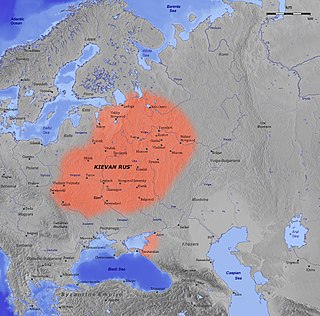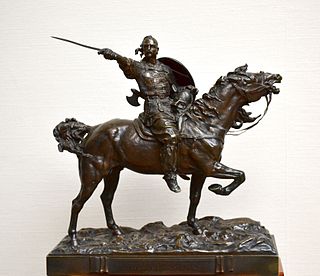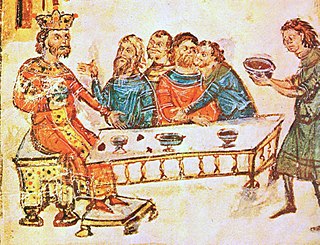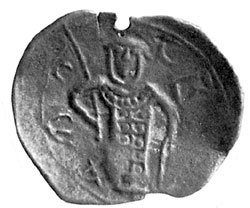
Year 969 (CMLXIX) was a common year starting on Friday of the Julian calendar, the 969th year of the Common Era (CE) and Anno Domini (AD) designations, the 969th year of the 1st millennium, the 69th year of the 10th century, and the 10th and last year of the 960s decade.

Year 968 (CMLXVIII) was a leap year starting on Wednesday of the Julian calendar.

Sviatoslav or Svyatoslav I Igorevich was Prince of Kiev from 945 until his death in 972. He is known for his persistent campaigns in the east and south, which precipitated the collapse of two great powers in Eastern Europe, Khazaria and the First Bulgarian Empire. He conquered numerous East Slavic tribes, defeated the Alans and attacked the Volga Bulgars, and at times was allied with the Pechenegs and Magyars (Hungarians).

Year 970 (CMLXX) was a common year starting on Saturday of the Julian calendar, the 970th year of the Common Era (CE) and Anno Domini designations, the 970th year of the 1st millennium, the 70th year of the 10th century, and the 1st year of the 970s decade.

Peter I was emperor (tsar) of Bulgaria from 27 May 927 to 969. Facing the Bogomil heresy and rebellions by his brothers and also by Časlav Klonimirović early on in his reign, Peter secured more success later in life; he ensured the retreat of the invading Rus by inciting Bulgaria's allies, the Pechenegs, to attack Kiev itself. Traditionally seen as a weak ruler who lost land and prestige, recent scholarship challenges this view, emphasizing the empire's affluence and internal peace. Considered a good ruler during the Middle Ages, his name was adopted by later leaders trying to restore Bulgarian independence under Byzantine rule to emphasize legitimacy and continuity.

Boris II was emperor (tsar) of Bulgaria from 969 to 977.
Pereyaslavets or Preslavets was a trade city located near mouths of the Danube. The city's name is derived from that of the Bulgarian capital of the time, Preslav, and means Little Preslav. In Greek it was also known as Presthlavitza (Πρεσθλαβίτζα). Several theories exist regarding the exact location of the city: either at Preslav or in its vicinity in Bulgaria, or at Isaccea, Nufăru, Murighiol or Jurilovca in Romania.

Boris, Borys or Barys is a male name of Bulgar origin. It is most commonly used in Russia, Belarus, Ukraine, Bulgaria, Serbia, Bosnia and Herzegovina, Croatia, North Macedonia, Montenegro, Slovakia, Slovenia and other countries in Eastern Europe. It is also used in Greece and countries that speak Germanic, Baltic and Romance languages. The spelling variant Borys is more common in Poland.

The First Bulgarian Empire was a medieval state that existed in Southeastern Europe between the 7th and 11th centuries AD. It was founded in 680–681 after part of the Bulgars, led by Asparuh, moved south to the northeastern Balkans. There they secured Byzantine recognition of their right to settle south of the Danube by defeating – possibly with the help of local South Slavic tribes – the Byzantine army led by Constantine IV. During the 9th and 10th century, Bulgaria at the height of its power spread from the Danube Bend to the Black Sea and from the Dnieper River to the Adriatic Sea and became an important power in the region competing with the Byzantine Empire.

The Battle of Dorostopol or Dorystolon was fought in 971 between the Byzantine Empire and forces of Kievan Rus'. The Byzantines, led by John I Tzimiskes, were victorious.
The Battle of Arcadiopolis was fought in 970 between a Byzantine army under Bardas Skleros and a Rus' army, the latter also including allied Bulgarian, Pecheneg, and Hungarian (Magyar) contingents. In the preceding years, the Rus' ruler Sviatoslav had conquered northern Bulgaria, and was now menacing Byzantium as well. The Rus' force had been advancing through Thrace towards Constantinople when it was met by Skleros' force. Having fewer men than the Rus', Skleros prepared an ambush and attacked the Rus' army with a portion of his force. The Byzantines then feigned retreat, and succeeded in drawing off the Pecheneg contingent into the ambush, routing it. The remainder of the Rus' army then suffered heavy casualties from the pursuing Byzantines. The battle was important as it bought time for the Byzantine emperor John I Tzimiskes to settle his internal problems and assemble a large expedition, which eventually defeated Sviatoslav the next year.

The siege of Constantinople of 860 was the only major military expedition of the Rus' Khaganate recorded in Byzantine and Western European sources. The casus belli was the construction of the fortress Sarkel by Byzantine engineers, restricting the Rus' trade route along the Don River in favour of the Khazars. Accounts vary, with discrepancies between contemporary and later sources, and the outcome is unknown in detail.
The battle of Bitola took place near the town of Bitola, in Bulgarian territory, between a Bulgarian army under the command of the voivode Ivats and a Byzantine army led by the strategos George Gonitsiates. It was one of the last open battles between the First Bulgarian Empire and the Byzantine Empire. The Bulgarians were victorious and the Byzantine Emperor Basil II had to retreat from the Bulgarian capital Ohrid, whose outer walls were by that time already breached by the Bulgarians. However, the Bulgarian victory only postponed the fall of Bulgaria to Byzantine rule in 1018.

The battle of Setina took place in the autumn of 1017 near the village of Setina in modern northern Greece between the armies of Bulgaria and Byzantium. The result was a Byzantine victory.

The medieval Bulgarian army was the primary military body of the First and the Second Bulgarian Empires, and some Puppet states of the former, like the Despotate of Dobruja. During the first decades after the foundation of the country, the army consisted of a Bulgar cavalry and a Slavic infantry. The core of the Bulgarian army was the heavy cavalry, which consisted of ca. 12,000 heavily armed riders. At its height in the 9th and 10th centuries, it was one of the most formidable military forces in Europe and was feared by its enemies. There are several documented cases of Byzantine commanders abandoning an invasion because of a reluctance to confront the Bulgarian army on its home territory.

Kievan Rus', also known as Kyivan Rus', was a state and later an amalgam of principalities in Eastern and Northern Europe from the late 9th to the mid-13th century. The name was coined by Russian historians in the 19th century. Encompassing a variety of polities and peoples, including East Slavic, Norse, and Finnic, it was ruled by the Rurik dynasty, founded by the Varangian prince Rurik. The modern nations of Belarus, Russia, and Ukraine all claim Kievan Rus' as their cultural ancestor, with Belarus and Russia deriving their names from it, and the name Kievan Rus' derived from what is now the capital of Ukraine. At its greatest extent in the mid-11th century, Kievan Rus' stretched from the White Sea in the north to the Black Sea in the south and from the headwaters of the Vistula in the west to the Taman Peninsula in the east, uniting the East Slavic tribes.

From c. 970 until 1018, a series of conflicts between the Bulgarian Empire and the Byzantine Empire led to the gradual reconquest of Bulgaria by the Byzantines, who thus re-established their control over the entire Balkan peninsula for the first time since the 7th-century Slavic invasions. The struggle began with the incorporation of eastern Bulgaria after the Russo-Byzantine War (970–971). Bulgarian resistance was led by the Cometopuli brothers, who – based in the unconquered western regions of the Bulgarian Empire – led it until its fall under Byzantine rule in 1018.

Jacob Svetoslav was a prominent 13th-century Bulgarian noble (bolyarin) of Rus' origin. Bestowed the title of despot, Jacob Svetoslav was the ruler of a widely autonomous domain of the Second Bulgarian Empire most likely located around Sofia. Seeking further independence and claiming the title of Emperor of Bulgaria, he twice changed allegiance from Bulgaria to the Kingdom of Hungary and vice versa, and the Hungarians recognized his Bulgarian royal rank as their vassal and ruler of Vidin.

Sviatoslav's invasion of Bulgaria refers to a conflict beginning in 967/968 and ending in 971, carried out in the eastern Balkans, and involving the Kievan Rus', Bulgaria, and the Byzantine Empire. The Byzantines encouraged the Rus' ruler Sviatoslav to attack Bulgaria, leading to the defeat of the Bulgarian forces and the occupation of the northern and north-eastern part of the country by the Rus' for the following two years. The allies then turned against each other, and the ensuing military confrontation ended with a Byzantine victory. The Rus' withdrew and eastern Bulgaria was incorporated into the Byzantine Empire.
Prespa was a medieval town, situated in the homonymous area in south-western Macedonia. It was a residence and burial place of the Bulgarian emperor Samuel and according to some sources capital of the First Bulgarian Empire and seat of the Bulgarian Patriarchate in the last decades of the 10th century.
















